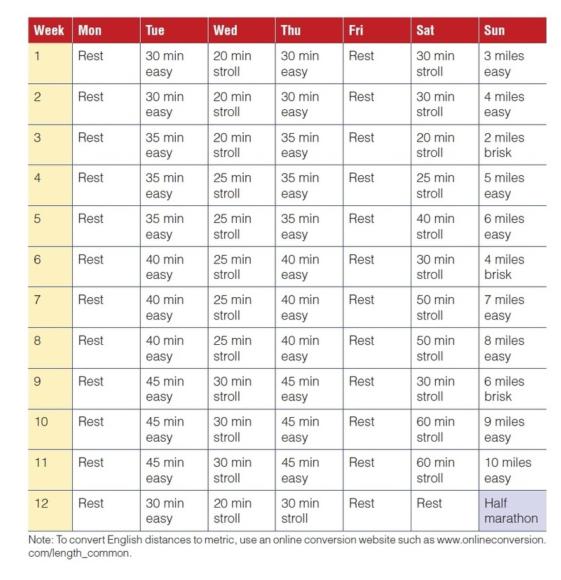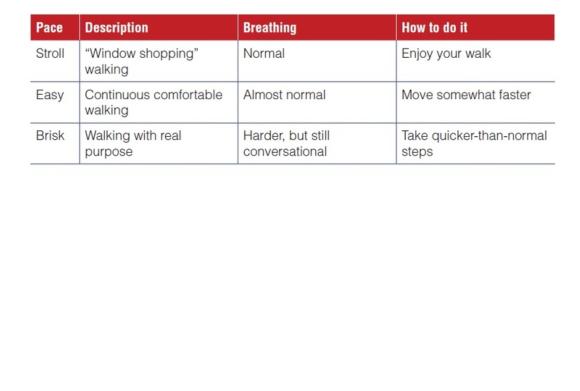Walking Training Program
This is an excerpt from Hal Higdon's Half Marathon Training by Hal Higdon.

Once you have chosen your half marathon, the secret to success is consistency. There's that word again, but you need to make walking a regular habit - a daily habit, not just something you do on the weekends or when the weather is nice. Walking coach Mark Fenton states, "The fitness walker must make a positive commitment to exercise a certain number of days a week over a specific distance or length of time, even if some of those days show fairly modest efforts" (Higdon, 1997b, p. 158).
Here's how to begin. The walking program, same as most of my running programs for the half, lasts 12 weeks and begins at a fairly easy level. In week 1, you walk for short amounts of time on three weekdays: Tuesday 30 minutes, Wednesday 20 minutes, and Thursday 30 minutes. (One difference between my running programs and my walking program is that for the former, I prescribe in miles, for the latter in minutes.)
Rest
Rest is important, and because the hardest workouts come on the weekends, I prescribe rest on Mondays, allowing you to recover from the weekend, then I prescribe rest again on Fridays to prepare you for the weekend workouts. If you decide you don't need much rest, particularly early in the program when minutes and miles are low, you won't find me standing on the sidewalk holding a stop sign. As the program nears its end with mileages of 8 (13 km), 9 (14.5 km) and 10 (16 km), you may be happy for these rest days. Incidentally, consider scheduling a massage on Mondays. It will help recovery.
On weekends we do the tough work. One day on the weekend (Saturday), you stroll at an easy pace, stroll being a Mark Fenton term, and I'll explain that in the section on pace that follows. The other weekend workout (Sunday) features a prescribed distance, the only workouts defined in miles: 3 miles (4.8 km) in week 1, 4 miles (6.4 km) in week 2, and so on to a maximum of 10 miles (16 km) in week 11, one week before the half marathon. The workouts on the weekend, as well as during the week, get progressively longer, thus more difficult. Because the increases are gradual, you should be able to manage the buildup without excessive strain. Before starting to train, let's consider some of the terms used, all borrowed from racewalker Mark Fenton.
Pace
Don't agonize too much about pace - how fast you walk - at least for the first few weeks. Walk at a stress-free pace. If training with a friend, the two of you should be able to hold a conversation. If you can't talk (and I don't mean talk into a cell phone), you're walking too fast. Mark believes that changing pace can be an effective training tool. You need not walk at the same pace day after day. Following are descriptions of three pace changes from stroll to easy to brisk. While it is easy for Mark and me to put labels on pace changes, inevitably you set your own pace. You determine how fast or slow you need to move to maximize your training without encountering the ogre: overtraining.

Stroll is the easiest pace. Walk as though you're window shopping at an outlet mall. Easy is just that: easy, but somewhat faster than stroll. Brisk suggests that you pick up the pace, getting just a little out of breath, walking fast enough that you don't notice the sign announcing a sale in the window of the store you just passed. Can you go faster than that? At levels above these three, walkers become power walkers or racewalkers, walking with an elbow-swinging, hip-wiggling form such as that used by those competing in the Olympic Games. You don't want to go that fast, although there are coaches and books to serve anyone who wants to walk at the competitive level.
Distance
This is a time-based program, meaning most of the workouts are prescribed in minutes rather than miles. Forget distance. If you must wear a GPS watch, don't let it force you to go far. Just walk the prescribed length of time and check the readouts later. If you know approximately how fast you walk, you can estimate distance, but during the week, distance is not important. You just want to get out regularly and exercise your legs. Remember the key word used so often in this book: consistency!
On Sundays, however, the training schedule does dictate workouts at distances, from 3 to 10 miles (4.8-16 km). Don't worry about walking precisely those distances, but you should come close. Pick a course out your back door or in a scenic area where you think you might enjoy walking and where there are a lot of runners and walkers and cyclists. In deciding where to train, talk to other walkers or runners. They probably can point you to accurately measured courses for your workouts. Where do you find these people? Most cities have specialty running stores that serve walkers as well as runners. By the way, when you visit such a store, get fitted with a comfortable pair of shoes that can serve you both in training and in your ultimate walking event. Be sure to tell the clerk that you are a walker rather than a runner, because it may make a difference in shoe choice.
Long Walks
The most important day of your workout week is Sunday - or the day when you do your long walks. You can flip-flop workouts, by the way, and walk long on any day that is most convenient. The long walks progressively increase in distance two weekends in a row with a third step-back week every third weekend to provide extra relaxation time and a psychological boost. This step-back pattern is one I developed for those using my full marathon programs, and it works well with half marathon walkers, too. Over 12 weeks, your longest walk will increase from 3 to 10 miles. Don't worry about making the final jump from 10 miles in practice to 13.1 miles in the race. Inspiration will carry you to the finish line, particularly if you taper the final week. Notice that week 12, the final week before the half marathon, features reduced mileage, or reduced "minute-age." This will allow you to arrive at the starting line with fresh legs.
Jogging
One way to get to the finish line faster is to do some jogging. If you were a competitive racewalker, you would get disqualified for starting to run, but because you are not competing for a prize, feel free to jog occasionally, either in training or in the half marathon itself. Jog in small segments: 50 to 100 meters every 10 minutes or so might be enough at first. Eventually you might want to expand your jogging segments, or even run the entire way, but don't do too much at first. Running is a more high-impact exercise than walking, so be cautious. Your goal should be to finish the half marathon, not finish it fast.
If you plan to jog and walk in a race that offers prizes in a walking category, you need to enter in the running division. It's unfair to those who walk the whole way for you to be ranked as finishing faster because you ran. If you suddenly become inspired and decide to break into a run a 100 or so yards out from the finish line, be aware that surrounding walkers may not consider that a friendly act. Edging past a walker with your last few strides and raising a fist while shouting, "Yes!" well, that's a no-no.
Take Time
Does the 12-week progression from 3 (4.8 km) to 13.1 miles seem too tough? Do you have more than a dozen weeks before your chosen half? Lengthen the schedule; take 18 or even 24 weeks to prepare. Repeat the week just completed before moving up to the next level. This training schedule is not carved in stone. Feel free to innovate if you feel you need more time to prepare. On the other hand, a lot of thought - both by Mark Fenton and me - went into creating a program offering a path to success. Don't stray too far afield, and you will keep both of us happy.
More Excerpts From Hal Higdon's Half Marathon TrainingSHOP

Get the latest insights with regular newsletters, plus periodic product information and special insider offers.
JOIN NOW


